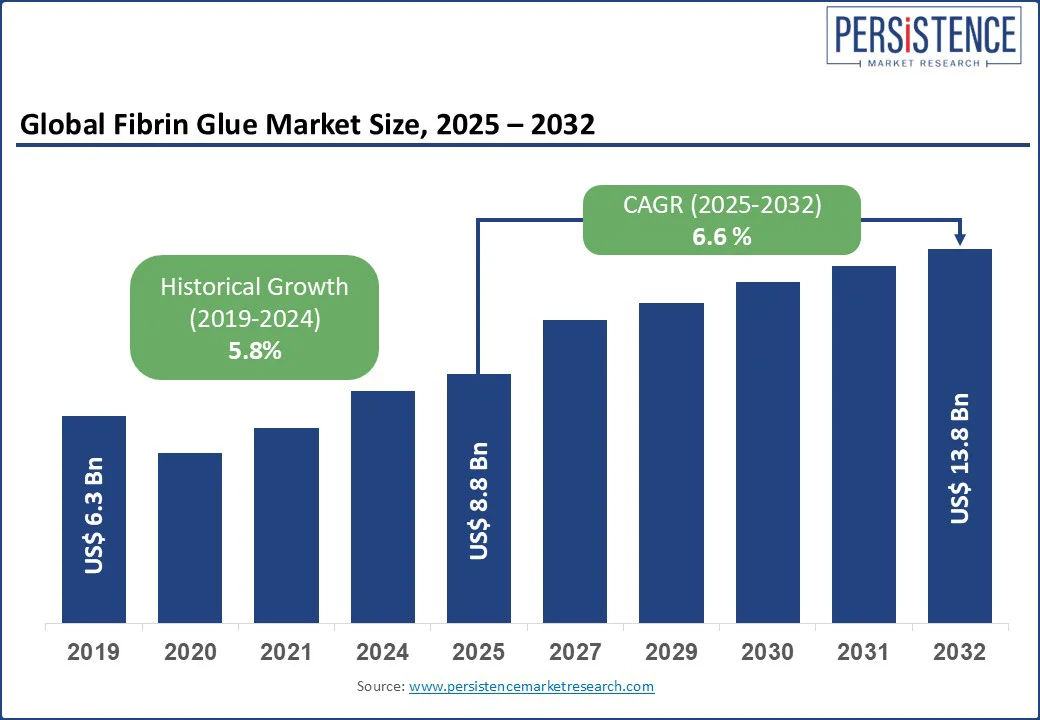ID: PMRREP3743| 181 Pages | 1 Aug 2025 | Format: PDF, Excel, PPT* | Healthcare

The global fibrin glue market is likely to be valued at US$8.8 Bn in 2025, and reach US$13.8 Bn by 2032, driven by CAGR of 6.6% from 2025 to 2032. Fibrin glue, a type of biological adhesive composed of fibrinogen and thrombin, is widely used in surgical procedures to support surgical hemostasis, tissue adhesion, and sealing. This tissue glue is vital in cardiac, pulmonary, vascular, orthopedic, and neurosurgeries, as well as wound management and general surgery. Market growth is fueled by the increasing number of surgical procedures, advancements in biocompatible surgical adhesives, and rising demand for minimally invasive surgery. Leading companies focus on innovation, partnerships, and global expansion to meet growing demand.

For instance, a study published in Heliyon compared mesh fixation methods in laparoscopic hernia repair and found that glue fixation resulted in lower early postoperative pain, reduced chronic pain, and a lower incidence of hematoma compared to traditional methods. The study also noted that patients in the glue group returned to work sooner, highlighting the benefits of fibrin glue in enhancing recovery times in MIS.
As healthcare systems globally prioritize efficient, patient-centric procedures, fibrin glue’s versatility and effectiveness make it indispensable. Innovations in delivery systems, such as sprayable formulations, further boost its adoption, driving market growth as MIS continues to reshape surgical practices worldwide.
As the population ages and NCDs proliferate, more patients undergo cardiac and vascular surgeries, creating a growing need for rapid and reliable bleeding control. Fibrin sealants are particularly vital in reoperations, bypass grafts, and aortic dissection repairs, where they significantly reduce postoperative bleeding and the incidence of emergency resternotomy.
For instance, A multicenter U.S. trial found fibrin sealants achieved hemostasis within 5 minutes in 92.6% of cardiac reoperations versus just 12.4% with conventional agents, also lowering resternotomy rates from ~10% to 5.6%.
Such compelling clinical evidence, aligned with the growing volume of surgeries driven by chronic disease prevalence, enhances the adoption trajectory of fibrin glue in hospitals and surgical centers worldwide.
Growth in Regenerative Medicine and Wound Healing Applications: The increasing adoption of fibrin glue in regenerative medicine and wound management presents a significant opportunity, particularly for chronic wound care and tissue regeneration. For instance, fibrin glue is used in treating diabetic ulcers, which affect 15% of diabetic patients globally (approximately 70 million people). Companies such as Baxter have developed fibrin-based products tailored for wound healing, such as Tisseel, which supports tissue sealing in burn treatment.
Orthopedic Surgery is the fastest-growing end user, propelled by rising joint replacement and trauma surgeries, particularly among the aging population. Fibrin glue is employed in these procedures as a hemostat to control bleeding, an adhesive to secure grafts or implants, and a sealant to prevent fluid leakage or promote tissue healing
North America holds the largest market share at 42%, with the U.S. contributing over 80% of the region’s revenue.
In the Europe region the Germany, the U.K., and France are leading due to their advanced medical systems and high surgical demand.
Asia Pacific is the fastest-growing region, led by China, India, and Japan.
Japan: A large aging population drives demand for fibrin glue in neurosurgery and wound management.
The global fibrin glue market is highly competitive. Key Strategies include R&D investment for innovative products, such as recombinant and nanotechnology-based fibrin glues, to meet safety and efficacy demands. Companies such as Baxter and BD focus on strategic acquisitions to expand market share, while Shanghai RAAS and Hualan Biological Engineering target the Asia Pacific through localized production. Partnerships with hospitals and ASCs are also common to enhance product adoption.
Recent developments include Johnson & Johnson’s 2024 launch of a next-generation fibrin sealant with enhanced biocompatibility, and Baxter’s US$50 million investment in recombinant fibrin glue production. CSL Behring partnered with a Chinese biotech firm in 2023 to expand its presence in Asia Pacific, while Cryolife introduced a new hemostat for neurosurgery in 2024.
The Fibrin Glue market is projected to reach US$8.8 billion in 2025.
The rising prevalence of chronic diseases and the growing demand for minimally invasive surgeries are the key market drivers.
The Fibrin Glue market is poised to witness a CAGR of 6.6% from 2025 to 2032.
Advancements in recombinant fibrin glue and biodegradable formulations are the key market opportunities.
Johnson & Johnson, Baxter, CSL Behring, Shanghai RAAS, Corza Health, Marquee Biosurgical, Hualan Biological Engineering, Becton Dickinson and Company (BD), Cryolife, and Nordson Corporation are key market players.
|
Report Attribute |
Details |
|
Historical Data/Actuals |
2019-2024 |
|
Forecast Period |
2025-2032 |
|
Market Analysis |
Value: US$ Bn/Mn, Volume: As Applicable |
|
2025 (E) |
US$ 8.8 |
|
2032 (F) |
US$ 13.8 |
|
Historical CAGR (2019-2024) |
5.8% |
|
Projected CAGR (2025-2032) |
6.6% |
|
Geographical Coverage |
|
|
Segmental Coverage |
|
|
Competitive Analysis |
|
|
Report Highlights |
|
|
Customization and Pricing |
Available upon request |
By Product Type
By Application
By End-Use
By Region
Delivery Timelines
For more information on this report and its delivery timelines please get in touch with our sales team.
About Author